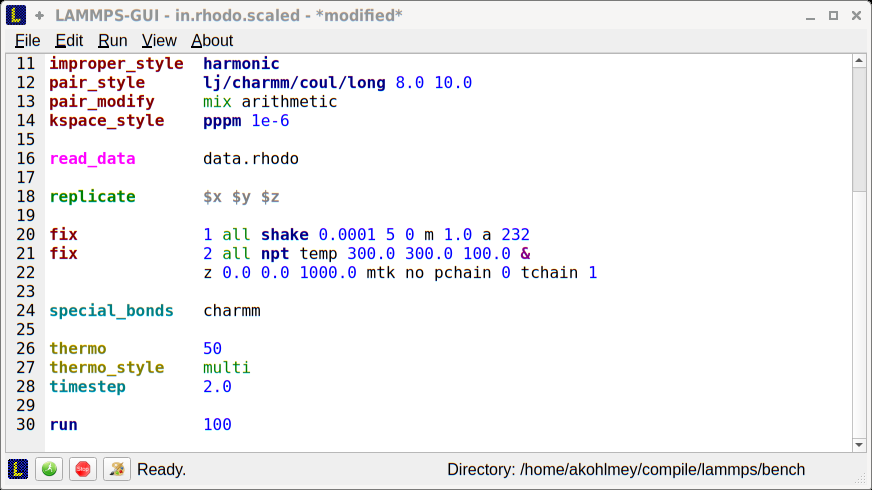首页根据提示,在右侧编辑器补充代码,计算输入样本与数组[23, 56, 74, 12, 27]的欧氏距离并反向传播。 函数编写步骤: 将输入的numpy数组 x 转换为FloatTensor, 并设置requires_grad=True 创建 FloatTensor([23, 56, 74, 12, 27]) 计算输入样本与已知样本的欧氏距离,并反向传播,返回数组 x 的梯度 import torch def get_gradient(x): return x.grad
根据提示,在右侧编辑器补充代码,计算输入样本与数组[23, 56, 74, 12, 27]的欧氏距离并反向传播。 函数编写步骤: 将输入的numpy数组 x 转换为FloatTensor, 并设置requires_grad=True 创建 FloatTensor([23, 56, 74, 12, 27]) 计算输入样本与已知样本的欧氏距离,并反向传播,返回数组 x 的梯度 import torch def get_gradient(x): return x.grad
时间: 2024-03-07 13:49:46 浏览: 74
好的,根据你的要求,以下是计算输入样本与数组[23, 56, 74, 12, 27]的欧氏距离并反向传播的代码:
```python
import torch
def get_gradient(x):
# 将输入的numpy数组 x 转换为FloatTensor,并设置requires_grad=True
x_tensor = torch.FloatTensor(x)
x_tensor.requires_grad_(True)
# 创建 FloatTensor([23, 56, 74, 12, 27])
y_tensor = torch.FloatTensor([23, 56, 74, 12, 27])
# 计算输入样本与已知样本的欧氏距离
distance = torch.sqrt(torch.sum(torch.pow(x_tensor - y_tensor, 2)))
# 反向传播
distance.backward()
# 返回数组 x 的梯度
return x_tensor.grad.numpy()
```
以上代码中,首先将输入的numpy数组x转换为FloatTensor,并设置requires_grad=True,这样可以计算x的梯度。然后创建FloatTensor([23, 56, 74, 12, 27]),计算输入样本与已知样本的欧氏距离distance,并调用backward()方法反向传播,计算x的梯度。最后将x的梯度转换为numpy数组并返回。
阅读全文
CSDN会员
开通CSDN年卡参与万元壕礼抽奖
大家在看
新项目基于YOLOv8的人员溺水检测告警监控系统python源码(精确度高)+模型+评估指标曲线+精美GUI界面.zip
新项目基于YOLOv8的人员溺水检测告警监控系统python源码(精确度高)+模型+评估指标曲线+精美GUI界面.zip
【环境配置】
1、下载安装anaconda、pycharm
2、打开anaconda,在anaconda promt终端,新建一个python3.9的虚拟环境
3、激活该虚拟空间,然后pip install -r requirements.txt,安装里面的软件包
4、识别检测['Drowning', 'Person out of water', 'Swimming']
【运行操作】
以上环境配置成功后,运行main.py,打开界面,自动加载模型,开始测试即可
可以检测本地图片、视频、摄像头实时画面
【数据集】
本项目使用的数据集下载地址为:
https://download.csdn.net/download/DeepLearning_/89398245
【特别强调】
1、csdn上资源保证是完整最新,会不定期更新优化;
2、请用自己的账号在csdn官网下载,若通过第三方代下,博主不对您下载的资源作任何保证,且不提供任何形式的技术支持和答疑!!!
SPiiPlus ACSPL+ Command & Variable Reference Guide.pdf
SPiiPlus ACSPL+驱动器编程命令说明书。驱动器编程命令语言说明。可参看驱动器编程。SPiiPlus ACSPL+ Command & Variable Reference Guide
论文研究 - 基于UPQC的电能质量模糊控制器的实现。
本文介绍了有关统一电能质量调节器(UPQC)的总体检查,以在电气系统的配电级别上激发电能问题。 如今,电力电子研究已经增加了电能质量研究的重要性,对于具体示例,定制功率设备(CPD)和柔性交流输电位置(FACTS)设备而言,这非常重要。 本文提供的方法利用统一电能质量调节器(UPQC)的串联和并联补偿器,在电压波动时与源电流同相注入补偿电压。 基于模糊逻辑控制器,研究了UPQC两种结构在左,右分流(L-UPQC)和右-分流(R-UPQC)的执行情况,以提高单个馈线配电系统的电能质量价值。通过MATLAB / Simulink编程。 这项研究分析了各种电能质量问题。 最后,在此建议的电源系统中,右分流UPQC的性能优于。
ChinaTest2013-测试人的能力和发展-杨晓慧
测试人的能力和发展-杨晓慧(华为)--ChinaTest2013大会主题演讲PPT。
Pattern Recognition and Machine Learning习题答案(英文)
Pattern Recognition and Machine Learning习题答案(英文)
最新推荐
WildFly 8.x中Apache Camel结合REST和Swagger的演示
资源摘要信息:"CamelEE7RestSwagger:Camel on EE 7 with REST and Swagger Demo"
在深入分析这个资源之前,我们需要先了解几个关键的技术组件,它们是Apache Camel、WildFly、Java DSL、REST服务和Swagger。下面是这些知识点的详细解析:
1. Apache Camel框架:
Apache Camel是一个开源的集成框架,它允许开发者采用企业集成模式(Enterprise Integration Patterns,EIP)来实现不同的系统、应用程序和语言之间的无缝集成。Camel基于路由和转换机制,提供了各种组件以支持不同类型的传输和协议,包括HTTP、JMS、TCP/IP等。
2. WildFly应用服务器:
WildFly(以前称为JBoss AS)是一款开源的Java应用服务器,由Red Hat开发。它支持最新的Java EE(企业版Java)规范,是Java企业应用开发中的关键组件之一。WildFly提供了一个全面的Java EE平台,用于部署和管理企业级应用程序。
3. Java DSL(领域特定语言):
Java DSL是一种专门针对特定领域设计的语言,它是用Java编写的小型语言,可以在Camel中用来定义路由规则。DSL可以提供更简单、更直观的语法来表达复杂的集成逻辑,它使开发者能够以一种更接近业务逻辑的方式来编写集成代码。
4. REST服务:
REST(Representational State Transfer)是一种软件架构风格,用于网络上客户端和服务器之间的通信。在RESTful架构中,网络上的每个资源都被唯一标识,并且可以使用标准的HTTP方法(如GET、POST、PUT、DELETE等)进行操作。RESTful服务因其轻量级、易于理解和使用的特性,已经成为Web服务设计的主流风格。
5. Swagger:
Swagger是一个开源的框架,它提供了一种标准的方式来设计、构建、记录和使用RESTful Web服务。Swagger允许开发者描述API的结构,这样就可以自动生成文档、客户端库和服务器存根。通过Swagger,可以清晰地了解API提供的功能和如何使用这些API,从而提高API的可用性和开发效率。
结合以上知识点,CamelEE7RestSwagger这个资源演示了如何在WildFly应用服务器上使用Apache Camel创建RESTful服务,并通过Swagger来记录和展示API信息。整个过程涉及以下几个技术步骤:
- 首先,需要在WildFly上设置和配置Camel环境,确保Camel能够运行并且可以作为路由引擎来使用。
- 其次,通过Java DSL编写Camel路由,定义如何处理来自客户端的HTTP请求,并根据请求的不同执行相应的业务逻辑。
- 接下来,使用Swagger来记录和描述创建的REST API。这包括定义API的路径、支持的操作、请求参数和响应格式等。
- 最后,通过Swagger提供的工具生成API文档和客户端代码,以及服务器端的存根代码,从而使得开发者可以更加便捷地理解和使用这些RESTful服务。
这个资源的实践演示对于想要学习如何在Java EE平台上使用Camel集成框架,并且希望提供和记录REST服务的开发者来说是非常有价值的。通过这种方式,开发者可以更加快速和简单地创建和管理Web服务,同时也增强了API的可访问性和可维护性。
管理建模和仿真的文件
管理Boualem Benatallah引用此版本:布阿利姆·贝纳塔拉。管理建模和仿真。约瑟夫-傅立叶大学-格勒诺布尔第一大学,1996年。法语。NNT:电话:00345357HAL ID:电话:00345357https://theses.hal.science/tel-003453572008年12月9日提交HAL是一个多学科的开放存取档案馆,用于存放和传播科学研究论文,无论它们是否被公开。论文可以来自法国或国外的教学和研究机构,也可以来自公共或私人研究中心。L’archive ouverte pluridisciplinaire
【声子晶体模拟全能指南】:20年经验技术大佬带你从入门到精通

# 摘要
声子晶体作为一种具有周期性结构的材料,在声学隐身、微波和红外领域具有广泛的应用潜力。本文从基础理论出发,深入探讨了声子晶体的概念、物理模型和声子带结构的理论解析,同时介绍了声子晶体的数值模拟方法,包括有限元方法(FEM)、离散元方法(DEM)和分子动力学(MD)。本文还提供了一套完整的声子晶体模拟实践指南,涵盖了模拟前的准备工作、详细的模拟步骤以及结果验证和案例分析。此外,文章探讨了声子晶体模拟的高级技巧和拓展
2024-07-27怎么用python转换成农历日期
在Python中,可以使用`lunarcalendar`库来将公历日期转换为农历日期。首先,你需要安装这个库,可以通过pip命令进行安装:
```bash
pip install lunarcalendar
```
安装完成后,你可以使用以下代码将公历日期转换为农历日期:
```python
from lunarcalendar import Converter, Solar, Lunar, DateNotExist
# 创建一个公历日期对象
solar_date = Solar(2024, 7, 27)
# 将公历日期转换为农历日期
try:
lunar_date = Co
FDFS客户端Python库1.2.6版本发布
资源摘要信息:"FastDFS是一个开源的轻量级分布式文件系统,它对文件进行管理,功能包括文件存储、文件同步、文件访问等,适用于大规模文件存储和高并发访问场景。FastDFS为互联网应用量身定制,充分考虑了冗余备份、负载均衡、线性扩容等机制,保证系统的高可用性和扩展性。
FastDFS 架构包含两个主要的角色:Tracker Server 和 Storage Server。Tracker Server 作用是负载均衡和调度,它接受客户端的请求,为客户端提供文件访问的路径。Storage Server 作用是文件存储,一个 Storage Server 中可以有多个存储路径,文件可以存储在不同的路径上。FastDFS 通过 Tracker Server 和 Storage Server 的配合,可以完成文件上传、下载、删除等操作。
Python 客户端库 fdfs-client-py 是为了解决 FastDFS 文件系统在 Python 环境下的使用。fdfs-client-py 使用了 Thrift 协议,提供了文件上传、下载、删除、查询等接口,使得开发者可以更容易地利用 FastDFS 文件系统进行开发。fdfs-client-py 通常作为 Python 应用程序的一个依赖包进行安装。
针对提供的压缩包文件名 fdfs-client-py-master,这很可能是一个开源项目库的名称。根据文件名和标签“fdfs”,我们可以推测该压缩包包含的是 FastDFS 的 Python 客户端库的源代码文件。这些文件可以用于构建、修改以及扩展 fdfs-client-py 功能以满足特定需求。
由于“标题”和“描述”均与“fdfs-client-py-master1.2.6.zip”有关,没有提供其它具体的信息,因此无法从标题和描述中提取更多的知识点。而压缩包文件名称列表中只有一个文件“fdfs-client-py-master”,这表明我们目前讨论的资源摘要信息是基于对 FastDFS 的 Python 客户端库的一般性了解,而非基于具体文件内容的分析。
根据标签“fdfs”,我们可以深入探讨 FastDFS 相关的概念和技术细节,例如:
- FastDFS 的分布式架构设计
- 文件上传下载机制
- 文件同步机制
- 元数据管理
- Tracker Server 的工作原理
- Storage Server 的工作原理
- 容错和数据恢复机制
- 系统的扩展性和弹性伸缩
在实际使用中,开发者可以通过 fdfs-client-py 库来与 FastDFS 文件系统进行交互,利用其提供的 API 接口实现文件的存储、管理等功能,从而开发出高效、可靠的文件处理应用。开发者可以根据项目的实际需求,选择合适的 FastDFS 版本,并根据官方文档进行安装、配置及优化,确保系统稳定运行。
总的来说,fdfs-client-py 是 FastDFS 文件系统与 Python 应用之间的一座桥梁,它使得开发者能够更加方便地将 FastDFS 集成到基于 Python 开发的应用中,发挥出 FastDFS 在文件管理方面的优势。"
"互动学习:行动中的多样性与论文攻读经历"
多样性她- 事实上SCI NCES你的时间表ECOLEDO C Tora SC和NCESPOUR l’Ingén学习互动,互动学习以行动为中心的强化学习学会互动,互动学习,以行动为中心的强化学习计算机科学博士论文于2021年9月28日在Villeneuve d'Asq公开支持马修·瑟林评审团主席法布里斯·勒菲弗尔阿维尼翁大学教授论文指导奥利维尔·皮耶昆谷歌研究教授:智囊团论文联合主任菲利普·普雷教授,大学。里尔/CRISTAL/因里亚报告员奥利维耶·西格德索邦大学报告员卢多维奇·德诺耶教授,Facebook /索邦大学审查员越南圣迈IMT Atlantic高级讲师邀请弗洛里安·斯特鲁布博士,Deepmind对于那些及时看到自己错误的人...3谢谢你首先,我要感谢我的两位博士生导师Olivier和Philippe。奥利维尔,"站在巨人的肩膀上"这句话对你来说完全有意义了。从科学上讲,你知道在这篇论文的(许多)错误中,你是我可以依
传感器集成全攻略:ICM-42688-P运动设备应用详解

# 摘要
ICM-42688-P传感器作为一种先进的惯性测量单元,广泛应用于多种运动设备中。本文首先介绍了ICM-42688-P传感器的基本概述和技术规格,然后深入探讨了其编程基础,包括软件接口、数据读取处理及校准测试。接着,本文详细分析了该传感器在嵌入式系统、运动控制和人机交互设备中的实践应用,并且探讨了高级功能开发,
matlab 中实现 astar
在MATLAB中,A*算法是一种用于求解最短路径问题的启发式搜索算法。它适用于带权重的图或网格,特别是当有大量潜在解决方案时,比如迷宫寻路问题。以下是使用MATLAB基本步骤来实现A*算法:
1. **数据结构准备**:
- 创建一个二维数组表示地图,其中0代表可以通行的节点,其他值代表障碍物或边界。
- 定义一个队列(通常使用`prioritiesqueue`)来存储待探索的节点及其信息。
2. **初始化**:
- 设定起始节点(start),目标节点(goal),以及每个节点的初始g值(从起点到该点的实际代价)和f值(g值加上估计的h值,即启发函数)。
3.
掌握Dash-Website构建Python数据可视化网站
资源摘要信息:"Dash-Website"
1. Python编程语言
Python是一种广泛使用的高级编程语言,以其简洁明了的语法和强大的功能而受到开发者的青睐。Python支持多种编程范式,包括面向对象、命令式、函数式和过程式编程。它的设计哲学强调代码的可读性和简洁的语法(尤其是使用空格缩进来区分代码块,而不是使用大括号或关键字)。Python解释器和广泛的库支持使其可以广泛应用于Web开发、数据分析、人工智能、科学计算以及更多领域。
2. Dash框架
Dash是一个开源的Python框架,用于构建交互式的Web应用程序。Dash是专门为数据分析和数据科学团队设计的,它允许用户无需编写JavaScript、HTML和CSS就能创建功能丰富的Web应用。Dash应用由纯Python编写,这意味着数据科学家和分析师可以使用他们的数据分析技能,直接在Web环境中创建数据仪表板和交互式可视化。
3. Dash-Website
在给定的文件信息中,"Dash-Website" 可能指的是一个使用Dash框架创建的网站。Dash网站可能是一个用于展示数据、分析结果或者其他类型信息的Web平台。这个网站可能会使用Dash提供的组件,比如图表、滑块、输入框等,来实现复杂的用户交互。
4. Dash-Website-master
文件名称中的"Dash-Website-master"暗示这是一个版本控制仓库的主分支。在版本控制系统中,如Git,"master"分支通常是项目的默认分支,包含了最稳定的代码。这表明提供的压缩包子文件中包含了构建和维护Dash-Website所需的所有源代码文件、资源文件、配置文件和依赖声明文件。
5. GitHub和版本控制
虽然文件信息中没有明确指出,但通常在描述一个项目(例如网站)时,所提及的"压缩包子文件"很可能是源代码的压缩包,而且可能是从版本控制系统(如GitHub)中获取的。GitHub是一个基于Git的在线代码托管平台,它允许开发者存储和管理代码,并跟踪代码的变更历史。在GitHub上,一个项目被称为“仓库”(repository),开发者可以创建分支(branch)来独立开发新功能或进行实验,而"master"分支通常用作项目的主分支。
6. Dash的交互组件
Dash框架提供了一系列的交互式组件,允许用户通过Web界面与数据进行交互。这些组件包括但不限于:
- 输入组件,如文本框、滑块、下拉菜单和复选框。
- 图形组件,用于展示数据的图表和可视化。
- 输出组件,如文本显示、下载链接和图像显示。
- 布局组件,如行和列布局,以及HTML组件,如按钮和标签。
7. Dash的部署
创建完Dash应用后,需要将其部署到服务器上以供公众访问。Dash支持多种部署方式,包括通过Heroku、AWS、Google Cloud Platform和其他云服务。部署过程涉及到设置Web服务器、配置数据库(如果需要)以及确保应用运行环境稳定。Dash文档提供了详细的部署指南,帮助开发者将他们的应用上线。
8. 项目维护和贡献
项目如Dash-Website通常需要持续的维护和更新。开发者可能需要添加新功能、修复bug和优化性能。此外,开源项目也鼓励社区成员为其贡献代码或文档。GitHub平台为项目维护者和贡献者提供了一套工具,如Pull Requests、Issues、Wiki和讨论区,以便更高效地协作和沟通。
总结而言,从给定的文件信息来看,“Dash-Website”很可能是一个利用Python语言和Dash框架构建的交互式数据可视化网站,其源代码可能托管在GitHub上,并且有一个名为“Dash-Website-master”的主分支。该网站可能具有丰富的交互组件,支持数据展示和用户互动,并且可以通过各种方式部署到Web服务器上。此外,作为一个开源项目,它可能还涉及到社区维护和协作开发的过程。
关系数据表示学习
关系数据卢多维奇·多斯桑托斯引用此版本:卢多维奇·多斯桑托斯。关系数据的表示学习机器学习[cs.LG]。皮埃尔和玛丽·居里大学-巴黎第六大学,2017年。英语。NNT:2017PA066480。电话:01803188HAL ID:电话:01803188https://theses.hal.science/tel-01803188提交日期:2018年HAL是一个多学科的开放存取档案馆,用于存放和传播科学研究论文,无论它们是否被公开。论文可以来自法国或国外的教学和研究机构,也可以来自公共或私人研究中心。L’archive ouverte pluridisciplinaireUNIVERSITY PIERRE和 MARIE CURIE计算机科学、电信和电子学博士学院(巴黎)巴黎6号计算机科学实验室D八角形T HESIS关系数据表示学习作者:Ludovic DOS SAntos主管:Patrick GALLINARI联合主管:本杰明·P·伊沃瓦斯基为满足计算机科学博士学位的要求而提交的论文评审团成员:先生蒂埃里·A·退休记者先生尤尼斯·B·恩